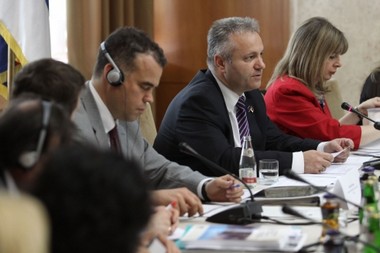- Serbia
Get to know Serbia
- Citizens
Culture and science
Health services
Pension and disability insurance
- Business
Employment
Economy
- Media
- Government
- Contact
Keep in touch
Contact form
Back
Keepin touch
Whether you have a question, comment, suggestion or any problem in the purview of the government, send us your message and we will try to respond as soon as possible. If your problem is not in our purview, we will forward your message to the relevant institution.
Q:
A:
Serbia’s economy should be export-oriented
Belgrade,
27 May 2010
Deputy Prime Minister and Minister of Economy and Regional Development Mladjan Dinkic said that no country from the region, including Serbia, can expect stable economic growth after an economic crisis if it does not change the structure of its economy.
Speaking at the promotion of the OECD Investment Reform Index 2010 (IRI 2010) in Serbia, Dinkic pointed out that the export orientation of the economy cannot be changed by macroeconomic measures.
He explained that monetary and fiscal policies are preconditions for macroeconomic stability, but that an appropriate industrial policy is the only one that can attract completely new investment and create an export-oriented economy.
That is precisely the strategy of the Serbian government and the Ministry of Economy and Regional Development, Dinkic declared.
He outlined that the drop in GDP in Serbia last year was somewhat smaller than in other countries of the region and it stood at 2.8%, while in EU countries, the recorded drop in GDP was 4.2%.
The signs of recovery from the crisis have been clearly seen this year, but the recovery is slower than we would wish, Dinkic underlined.
Noting that industry is recovering very well, he said that production grew at a rate of 3% in the first quarter of the year. Exports are also growing with solid dynamics, which was 15% in the first quarter, while imports dropped by 5%, the Minister explained.
The level of foreign investment, which stood at $2 billion last year, was significantly lower due to the world economic crisis, the Minister stated.
State Secretary of the Ministry of Economy and Regional Development Vesna Arsic emphasised that the approach to investing in Serbia is above average in relation to other countries in South Eastern Europe.
She outlined that significant progress was made in many sectors related to the investment climate and attraction of investors.
She highlighted that OECD’s 2010 Investment Reform Index for Serbia showed that Serbia is above average in many respects but that there are areas where more work is necessary, such as the protection of intellectual property and ownership of land and construction.
Arsic explained that trade, import and export incentives and education are among the areas where improvement was made, but added that better communication is needed between education and needs of the real economy and entrepreneurs.
Red tape was also given a greater mark than before, the State Secretary added and announced more attention to bureaucracy in the future as well.
Investment promotion institutions, such as the Serbian Investment and Promotion Agency (SIEPA), were given the highest marks, she affirmed.
“Investment Reform Index 2010: Monitoring Policies and Institutions for Direct Investment” is a quantitative analysis of legal regulations and institutions in Southeastern Europe affecting a positive climate for foreign direct investment.
The Investment Reform Index 2010 monitors investment-related policy reforms in the economies of South East Europe and compares these to best practice in the OECD area.
He explained that monetary and fiscal policies are preconditions for macroeconomic stability, but that an appropriate industrial policy is the only one that can attract completely new investment and create an export-oriented economy.
That is precisely the strategy of the Serbian government and the Ministry of Economy and Regional Development, Dinkic declared.
He outlined that the drop in GDP in Serbia last year was somewhat smaller than in other countries of the region and it stood at 2.8%, while in EU countries, the recorded drop in GDP was 4.2%.
The signs of recovery from the crisis have been clearly seen this year, but the recovery is slower than we would wish, Dinkic underlined.
Noting that industry is recovering very well, he said that production grew at a rate of 3% in the first quarter of the year. Exports are also growing with solid dynamics, which was 15% in the first quarter, while imports dropped by 5%, the Minister explained.
The level of foreign investment, which stood at $2 billion last year, was significantly lower due to the world economic crisis, the Minister stated.
State Secretary of the Ministry of Economy and Regional Development Vesna Arsic emphasised that the approach to investing in Serbia is above average in relation to other countries in South Eastern Europe.
She outlined that significant progress was made in many sectors related to the investment climate and attraction of investors.
She highlighted that OECD’s 2010 Investment Reform Index for Serbia showed that Serbia is above average in many respects but that there are areas where more work is necessary, such as the protection of intellectual property and ownership of land and construction.
Arsic explained that trade, import and export incentives and education are among the areas where improvement was made, but added that better communication is needed between education and needs of the real economy and entrepreneurs.
Red tape was also given a greater mark than before, the State Secretary added and announced more attention to bureaucracy in the future as well.
Investment promotion institutions, such as the Serbian Investment and Promotion Agency (SIEPA), were given the highest marks, she affirmed.
“Investment Reform Index 2010: Monitoring Policies and Institutions for Direct Investment” is a quantitative analysis of legal regulations and institutions in Southeastern Europe affecting a positive climate for foreign direct investment.
The Investment Reform Index 2010 monitors investment-related policy reforms in the economies of South East Europe and compares these to best practice in the OECD area.
-
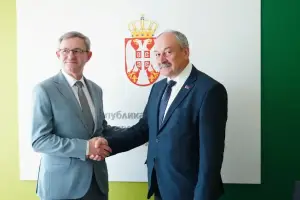 Belgrade, 11 July 2025
Belgrade, 11 July 2025Potential for improving cooperation with Belarus in many areas
-
 Požega, 5 July 2025
Požega, 5 July 2025Section of Pakovraće - Požega highway officially opened
-
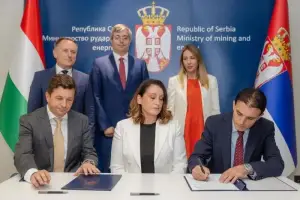 Belgrade, 2 July 2025
Belgrade, 2 July 2025Technical specifications defined for Serbia-Hungary oil pipeline
-
 Belgrade, 30 June 2025
Belgrade, 30 June 2025IMF confirms Serbia successfully implementing all agreed reforms
-
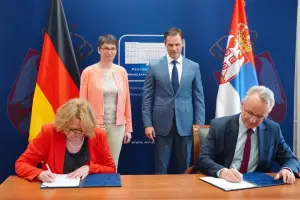 Belgrade, 27 June 2025
Belgrade, 27 June 2025Double Taxation Avoidance Agreement with Germany signed
-
 Kostolac, 25 June 2025
Kostolac, 25 June 2025Construction of Kostolac wind farm nearing completion
-
 Belgrade, 24 June 2025
Belgrade, 24 June 2025Government supports request for new postponement of sanctions against NIS
-
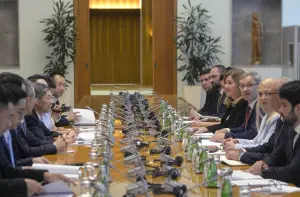 Belgrade, 23 June 2025
Belgrade, 23 June 2025Procedures to facilitate sale of Serbian products to China to be accelerated
-
 Belgrade, 21 June 2025
Belgrade, 21 June 2025Serbia receives first funds under Growth Plan for the Western Balkans
-
 Belgrade/Cairo, 20 June 2025
Belgrade/Cairo, 20 June 2025New phase in relations with Egypt in field of agriculture

